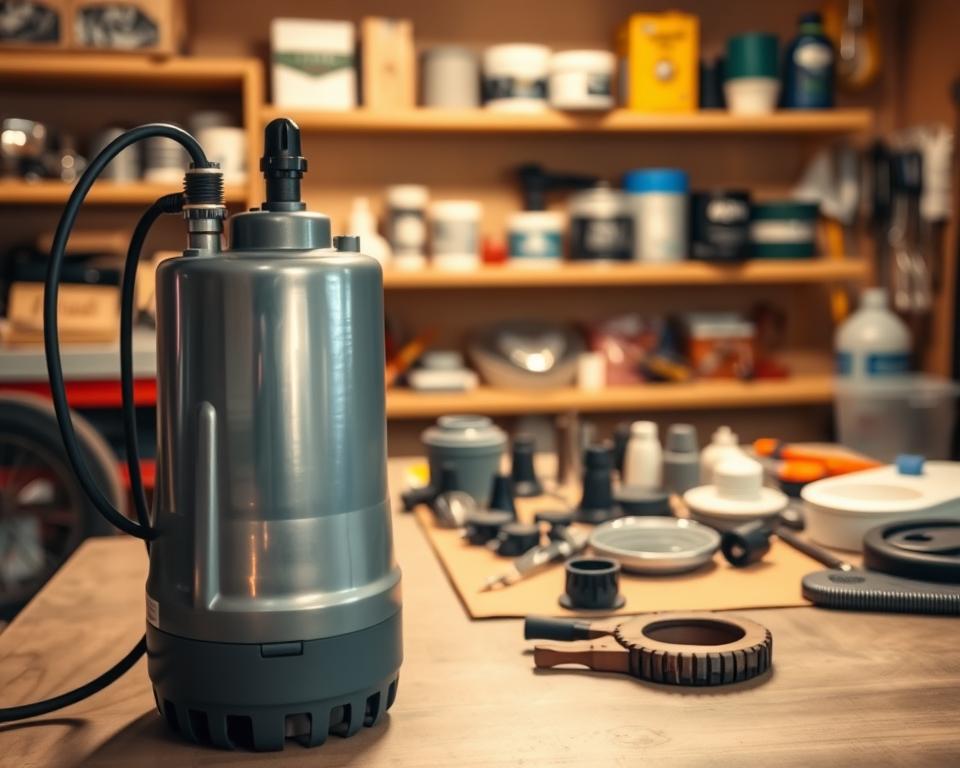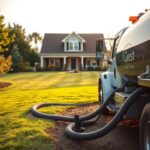RV Waste Tank Pumping: Vital Maintenance Advice
Imagine what happens when you ignore your RV’s sewer setup. Many RV owners find the idea of septic tank pumping daunting. However, realizing the importance of these maintenance practices is vital. These steps preserve your camping joy and avoid expensive repairs. Learning proper waste disposal is key to your septic health. We’ll share vital insights on RV black tank pump, including best practices and tips to keep your system running smoothly.
Getting to Know Your RV’s Waste Setup
Your RV includes tanks designed for different wastes. The system comprises a black water tank (toilet), a gray water tank (sinks/showers), and a fresh water tank. Grasping how each part works is key to proper black tank servicing and overall system care.
A series of drain lines and vent pipes balance waste flow and airflow. Understanding this synergy helps you avoid blockages and buildup. This knowledge ensures hassle-free trips and reliable waste handling.
Maintaining clear, working tanks requires routine effort. Frequently checking tank levels and emptying on time preserves comfort. By maintaining your RV’s septic system properly, you’ll improve its lifespan and enjoy every trip more.
Why Routine Tank Pumping Matters
Routine sewage draining preserves functionality and hygiene. Waste buildup triggers odors and backups that ruin outings. A full tank can produce embarrassing backups. Such mishaps kill the fun on the road.
Skipping pump-outs leads to pricey repairs. System failures cause leaks and wear out parts prematurely. Regular pumping ensures seamless operation. It prevents unwelcome surprises and roadside emergencies.
Proactive servicing stops clogs. Investing in pump-outs shows you care about your RV. It greatly improves your travel experience. By sticking to a dump schedule, you’ll relish the outdoors worry-free.
Recommended Pump-Out Intervals
Determining dump intervals needs careful thought. Generally, dump every 3–5 days when in use. Still, it varies with tank size and occupancy. Pinpointing the correct dump time is key for effective wastewater management.
Empty once the black tank reaches roughly 66% full. This prevents solids from clogging and keeps flow steady. Ignoring it can cause backups and unpleasant odors.
Various factors influence dump frequency, such as
- Number of people on board
- Length of stay
- Type of waste generated
- Tank capacity
Scheduling prevents on-the-road crises. Remember portable toilet service schedules. Knowing your patterns predicts when to dump.
| Usage Scenario | Pumping Frequency |
|---|---|
| Short Trip, Two Campers | Every 3–4 days |
| Extended Trip (4–6 people) | Every 2–3 days |
| Seasonal Living (2–4 people) | Weekly or Bi-Weekly |
Keep a close eye on tank levels and your habits. This proactive stance ensures enjoyable travel.

Best Practices for Dumping Your Tanks
Correct dumping preserves system health and prevents issues. Always empty the black tank first to protect the gray tank. This prevents dirty water from fouling the clean.
Using a high-quality hose minimizes leaks and ensures smooth dumping. Secure all fittings firmly to avoid leaks. After emptying, flush the black tank with plenty of water. This removes residue and preps the tank for next time.
Know where dump stations are located. This preparation streamlines your dump routine.
In short, follow these key steps for efficient dumping:
- Empty the black water tank first.
- Use a top-quality sewer hose.
- Flush the black tank thoroughly after emptying.
- Plan your dump station locations.
These tips refine your waste disposal process.
Tank Handling and Upkeep Best Practices
Knowing proper tank use and maintenance is crucial. Keep some water in the black tank for better breakdown.
Don’t flush wipes, feminine products, or paper towels. Use only RV-compatible paper. Regular checks spot leaks or cracks before they worsen.
Adding treatments now and then improves septic service. They introduce microbes that digest solids effectively. Such measures keep your tanks operating at their best.
- Check for leaks and damage often.
- Apply RV-specific chemical treatments.
- Keep vents clear to avoid odors.
Adhering to these practices safeguards your system. It also boosts your camping enjoyment.
Essential Pumping Tips
To pump your tank effectively, follow a methodical approach. Proper disposal prevents issues—only dump at approved stations. Understanding volume limits prevents spills on the go.
Check tank indicators regularly to time pump-outs. This extends tank life and enhances trip comfort. Setting a dumping schedule improves system efficiency.
Flush well after every emptying. It ensures each dump is cleaner than the last. By applying these strategies, you’ll maintain your RV’s condition and comfort.
Typical RV Septic Pitfalls
Maintaining your system is vital for uninterrupted camping. Not using enough water in the black tank leads to buildup. Adequate water use breaks down solids efficiently.
Flushing inappropriate items blocks pipes. Avoid non-dissolvable products like feminine hygiene items. They cause backups and costly service calls.
Keep the black tank valve closed until ready to dump. Open valves let water out but hold solids, causing residue. This ensures solids clear on each dump.
Awareness of these errors boosts system longevity. Avoiding them keeps your waste management reliable.
Signs You Need Expert Help
Knowing when to hire pros preserves system health. Persistent odors often indicate complex issues. Tanks that empty sluggishly hint at internal blockages.
Waste spillage near dump sites signals trouble. Such situations usually need high-pressure cleaning. Experts use specialized tools to clear stubborn clogs.
Routine professional inspections catch hidden issues early. Acting on findings quickly prevents bigger problems. Hiring qualified technicians saves time and money long term.
Ongoing Septic Care Tips
Smart upkeep ensures lasting system performance. Scheduled dumps preserve longevity and operation. Routine rinses clear residue and stave off expensive breakdowns.
Adopting sanitation routines protects your system. Checking seals and joints avoids leaks. Choosing eco-friendly treatments avoids damage.
Consider these long-term practices:
- Stick to a pump-out timetable.
- Rinse often to remove solids.
- Sanitize twice a year.
- Inspect parts frequently for wear and tear.
Proactive care delivers worry-free travel. Routine service lets you focus on the scenery, not your sewer.
The Final Word
Effective RV septic maintenance is crucial for a pleasant experience. Understanding operation and following guidelines prevents headaches. Regular black tank maintenance improves efficiency. This makes your journey more comfortable.
Consistent inspections and care deliver trouble-free trips. This reliability supports every outing. Adopting these habits keeps your RV ready to roll. So you can focus on making memories, not dealing with tanks.

